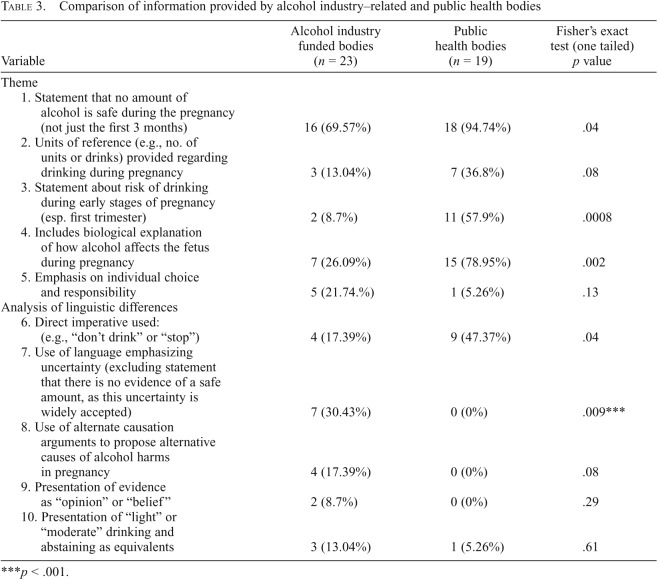Table 3.
Comparison of information provided by alcohol industry–related and public health bodies
| Variable | Alcohol industry funded bodies (n = 23) | Public health bodies (n = 19) | Fisher’s exact test (one tailed) p value |
| Theme | |||
| 1. Statement that no amount of alcohol is safe during the pregnancy (not just the first 3 months) | 16 (69.57%) | 18 (94.74%) | .04 |
| 2. Units of reference (e.g., no. of units or drinks) provided regarding drinking during pregnancy | 3 (13.04%) | 7 (36.8%) | .08 |
| 3. Statement about risk of drinking during early stages of pregnancy (esp. first trimester) | 2 (8.7%) | 11 (57.9%) | .0008 |
| 4. Includes biological explanation of how alcohol affects the fetus during pregnancy | 7 (26.09%) | 15 (78.95%) | .002 |
| 5. Emphasis on individual choice and responsibility | 5 (21.74.%) | 1 (5.26%) | .13 |
| Analysis of linguistic differences | |||
| 6. Direct imperative used: (e.g., “don’t drink” or “stop”) | 4 (17.39%) | 9 (47.37%) | .04 |
| 7. Use of language emphasizing uncertainty (excluding statement that there is no evidence of a safe amount, as this uncertainty is widely accepted) | 7 (30.43%) | 0 (0%) | .009*** |
| 8. Use of alternate causation arguments to propose alternative causes of alcohol harms in pregnancy | 4 (17.39%) | 0 (0%) | .08 |
| 9. Presentation of evidence as “opinion” or “belief” | 2 (8.7%) | 0 (0%) | .29 |
| 10. Presentation of “light” or “moderate” drinking and abstaining as equivalents | 3 (13.04%) | 1 (5.26%) | .61 |
p < .001.

